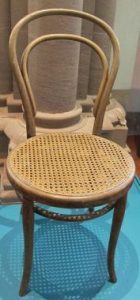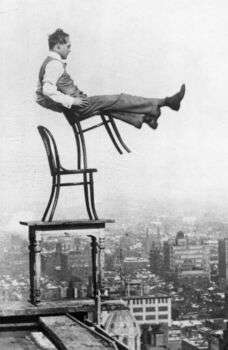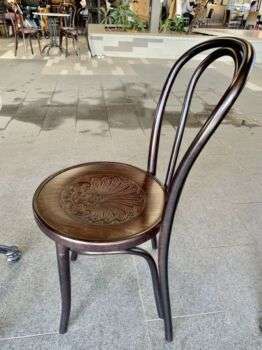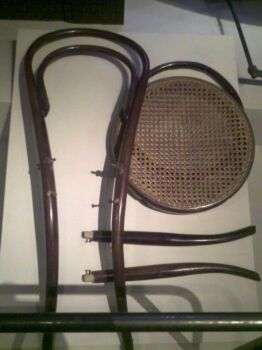German-Austrian cabinetmaker Michael Thonet created Chair 14, also known as the “Chair of Chairs,” in 1859. The piece is classic and believed to be the very first product of modern industrial design.

Image source: wikimedia
About Chair 14
Michael Thonet experimented for years to create the first mass-produced reasonably prieced chair. His ambitions were particularly daring. Alice Rousthorn wrote in the New York Times, “When the No.14 was launched in 1859, it was the first piece of furniture to be both attractive and inexpensive enough to appeal to everyone from aristocrats to schoolteachers. By 1930, some 50 million No.14s had been sold, and millions more have been snapped up since then.”

Image source: https://it.wikipedia.org
Bentwood chair, also known as the bistro chair, consists of six pieces of beech that are heated with steam, pressed into curved cast-iron molds, and then dried to the desired shape. Later versions had two diagonal supports added on each side to help secure the seat and backrest.
Impact of Chair 14
First, this chair satisfies its predetermined purpose, as every well-designed object must do. Second, it looks and feels outstanding. The German furniture designer Konstantin Grcic said, “It’s one of the most beautiful chairs there is, and it has exactly the right weight. When you pick it up, it feels perfect. That’s an important aspect of chair design that’s often overlooked.”
Additionally, Thonet chairs are widely used today and are some of the most popular chairs ever made. More than 180 years after their inception, Thonet chairs can be found in several restaurants, cafes, bars, bistros, boutiques, and homes around the world. Further, Bentwood chairs have belonged to many famous people: world leaders, artists, scientists, and many others, such as Albert Einstein, Joseph Stalin, Pablo Picasso, and Henri de Toulouse Lautrec. In fact, Lautrec’s “At the Moulin Rouge,” has two Bentwood chairs in the painting.

Image source: https://search.creativecommons.org/photos/58362539-eda4-43d5-90c0-89d98bf93a4a by jimmiehomeschoolmom
Industrial Design and Mass Production
During the 1851 World’s Fair in London, Thonet received a bronze medal for his Viennese Bent Wood Chairs. Then, his fame continued when he was awarded a silver medal at the next World’s Fair in 1855 in Paris, France for his famous No. 14 chair. Moreover, production methods improved and the demand for his chairs made it possible to acquire a new factory in Koricany, Moravia in 1856. Further, it is said that over 50 million chairs were produced before 1930.

Image source: https://search.creativecommons.org/photos/39783d53-a5b2-4aba-aeb5-d9c215a04082 by Kgbo
Chair Construction
The Model 14 Bentwood Chair is made up of just six components combined with a few screws and nuts. Initially, looking for simpler and cheaper means of production, Thonet used folded veneers glued together and held together in what is called a “Jig.” This proved to be a labor-intensive method, and the wood could only be bent in one direction. By adopting this method through further cutting, twisting, and buffing operations, Thonet obtained 3-dimensional curves with oval sections. His quest to get rid of glue led him to his revolutionary solution: a solid piece of steamed wood and a metal strap could be folded together without breaking the wood. Once dry, the wood would retain its new shape.

Image source: https://search.creativecommons.org/photos/1a499afa-054e-4773-948c-4f71d3d12955 by Tigist Sapphire
Therefore, a stronger chair was made with fewer pieces, fewer joints, and screws that replaced glue. In 1856, this modern and original process was patented by Thonet’s son, Gebrüder Thonet, and mass production followed. The design remained virtually unchanged for over 150 years.

Image source: https://search.creativecommons.org/photos/3821e3a2-4da5-4711-8aaa-3bc3995050eb by williamd
Info sourses:
